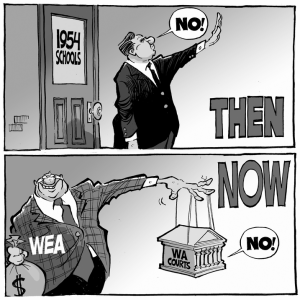Vol. 17, No. 38
MORATORIUM MADNESS. Nearly all Chicago aldermen (42 out of 50) have signed a resolution seeking a moratorium on new charter schools in the Windy City and across the state. The Illinois Network of Charter Schools says it best, writing the proposed moratorium is misguided and fails to acknowledge the reality that “60,000 Chicago parents have chosen to send their children to charter schools, and thousands of students continue to languish on charter school waitlists.” Those in favor of the moratorium are using the budget crisis as an excuse, saying that the city can barely afford to fund neighborhood schools, however this excuse is a tired one, and the reality is that charter schools have proven time and again to provide a bigger bang for buck. Take action now to let Illinois officials know that you do not support action that limits educational opportunities for children.
#SAVETHECHARTERSBMORE. This weekend 1,500 students, parents, teachers, and community members gathered in their #SaveTheChartersBmore shirts to rally in support of fair funding for Charm City public charter schools. The Maryland city’s 34 public charter schools educate nearly 14,000 students, and have more than 5,500 kids on wait lists – a clear sign that parents want more choices when it comes to their children’s education. The City Council voted unanimously to call on the school system to withdraw the proposed funding formula that would’ve reduced funding for charters, however next year’s funding remains unclear, reports the Baltimore Sun. Sadly, inequitable funding issues are just one of the many weaknesses of the state’s F-rated charter school law, and is why CER spoke out so strongly when the legislature gutted Governor Hogan’s proposal to improve the law for a state that ranks 43rd in Parent Power. Go to savethechartersbmore.org to make your voice heard.
COLORADO CHALLENGE. Late last week, news broke that Colorado parents are asking the U.S. Supreme Court to review the constitutionality of the Douglas County voucher program, which was ruled unconstitutional by the Colorado Supreme Court in June 2015. The program was ruled unconstitutional on the grounds of the state’s Blaine Amendment provisions, which place restrictions on aid to religious schools. The district contends Blaine Amendment provisions were designed as a result of anti-Catholic bias, and not only that, but since vouchers are provided directly to students, which are then paid to private schools by parents, funds technically do not flow directly to religious schools. Blaine Amendments have caused problems for school choice in other states, such as Florida and Michigan, however, North Carolina’s Blaine Amendment was not an issue for the state’s voucher program, which was not only recently ruled constitutional by the North Carolina Supreme Court but also expanded in the latest state budget. Here’s to hoping this case ends with a victory for Colorado #ParentPower.
#SAVEWACHARTERS FIGHTS ON. On September 24, the date of the original deadline to file a motion for reconsideration regarding the Washington State Supreme Court’s ruling of charter schools unconstitutional, Attorney General Bob Ferguson officially asked the state’s high court to re-evaluate its decision. But he’s not the only attorney general to think the charter school decision is mistaken and should be reversed, as four others have spoken out against the ruling. Kudos to the Washington official for questioning the ruling and “standing up for children and parents who have been stripped of a voice,” said CER President Kara Kerwin, “considering that Washington voters by a majority voted for parent power.”
BOEHNER BIDS FAREWELL. Last Friday, House Speaker John Boehner announced his resignation as speaker and from Congress at the end of October. In 2011, Boehner was honored with an EdReformie award for his achievements in creating opportunities for students and advancing substantive change in U.S. education. He’s been a tireless supporter of school choice who has never let political pressure get in the way of doing what’s best for kids, most notably his efforts to restore funding for DC’s voucher program. Thank you Speaker Boehner for being a champion for #ParentPower.
GET EXCITED… CER’s Education Tax Credit Laws Across the States, Ranking and Scorecard 2015 is out tomorrow! After our inaugural analysis last year, we’ve tweaked the methodology, placing far more emphasis on participation and implementation, taking a deeper dive into rules and regulations governing education tax credit programs. Because without considering implementation and participation, even the best-written school choice law is rendered meaningless.












Washington Yu Ying Charter School Recognized For Excellence By Michelle Obama
This weekend, First Lady Michelle Obama, Madame Peng, wife of President Xi of China, and students from the Washington Yu Ying Public Charter School, attended the naming ceremony of the new baby panda at the National Zoo in Washington, D.C. (his name is Bei Bei!) At this ceremony, the Yu Ying School was recognized by Michelle Obama for being part of the steps forward toward reaching the goal that President Obama and President Xi established: an initiative to teach one million students in the U.S. to speak Mandarin Chinese by the year 2020, the One Million Strong initiative.
Michelle Obama recognized that students at the Yu Ying School are among the first to be in an immersive school that promotes the idea of global citizenship, and the ability to connect with people around the world due to their early exposure to a different language and culture. She emphasized that this generation does not need to leave the country to be exposed to the rest of the world. That all is attainable with Internet access, and that Yu Ying students have the ability to extend their community across the world as they have the skills to do so. The First Lady encourages students worldwide to follow the Yu Ying students in their journey to expand their communities past language and cultural barriers.
Karina Lichtman, CER Intern